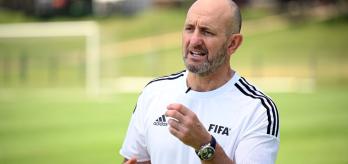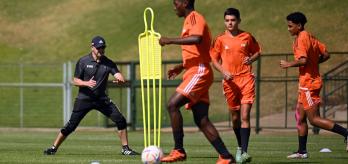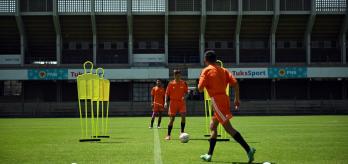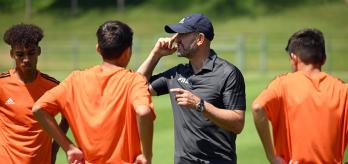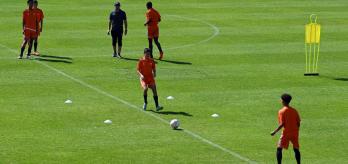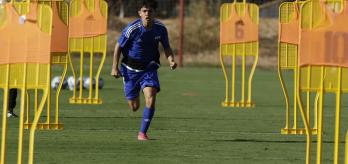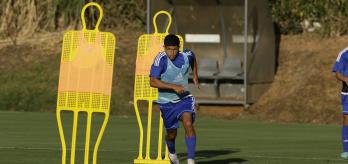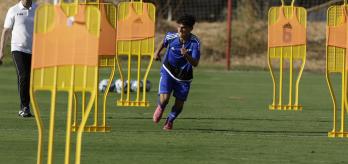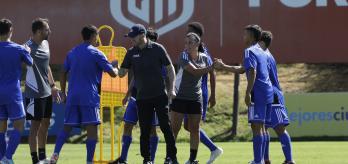This is achieved through a series of drills based on game scenarios and involving both individual and collective coordination.
Emphasis and methodology
The technical-physical training methodology from previous phases is applied to achieve the desired intensity, this time with repeated bouts of high-tempo technical interaction and high-quality connectivity between players. Movement and orientation are centred around offensive and defensive transitions and passing ranges of 5-15m.
The methodology applies a loaded functional exposure. To regulate overall speed intensity, the work-to-rest ratios are approximately 1:3 or 1:4 when targeting maximum tempo and as low as 1:1 when repeated work is the primary objective. The tempo and intensities used are appropriate for this phase of returning from injury. Drills are technically balanced and good footballing-awareness habits are to be encouraged.
The methodology places a loaded speed exposure in a functional football environment.
Overall objective and training perspective
Functional speed part II is appropriate as a one-off session for players following a short-term injury lay-off (i.e. two to three weeks) or for repeated bouts of work to help rebuild functional speed capacity for players who have been sidelined for an extended period (moving from progressive resistance to high-load demands). The individual drills are designed for a minimum of two players assisted by two servers. However, if there is only one working player, then two servers are required to fulfil the training requirements for most drills.

Implementation
Aimed at all on-the-field practitioners responsible for helping players return from injury, the drills in this session form part of an overall training programme to provide a variety of technical-physical training solutions (with a particular emphasis on the technical elements) for all phases of rehabilitation. Practitioners can select individual drills or entire sessions to fit their overall training plans for players in their care.
The drills within the session can be used for small training groups of four to six players. The emphasis is on high-volume acceleration-deceleration workloads and a technically biased approach.
Workload metrics
A simple table showing the duration of the drills, the number of sets, the work-to-rest ratios and guidelines for combining phase 1 and 3 drills can be found below.


Set-up for drills 1 to 4
Grid distances (1 to 4)
-
Set up a 30x20m outer grid using flat discs or cones (a+b).
-
Set up a grid with two sets of mannequin gates vertically down the middle of the outer grid (c). Place two double gates 16m apart between the gates (d).
-
Place two mannequin gates 18m apart horizontally across the middle of the outer grid (e).
-
Place two flat discs/cones 7m beyond the mannequin gates at each end (f).
-
Place two flat discs/cones 3-4m apart in line with the gates (g).
-
If no poles or mannequins are available, cones/discs may be used.
-
All drills require a minimum of four participants and a maximum of seven.
-
All drills are technically balanced, providing the opportunity to use both feet in equal measure.
-
The drills should start after a short period of familiarisation with the types of movement and relevant scenarios.
-
Ensure adequate recovery periods (as specified) between each repetition.
-
Encourage the players to maintain a good passing rhythm and tempo throughout the drills.
-
Encourage the players to change positions quickly during the technical interactions.
-
Periodically emphasise and encourage technical balance and reinforce awareness habits.
NB: For drills 1 and 2, there is a minimum of two working players and a maximum of five, plus two servers supporting the working players.
For drills 4 and 5, there is a minimum of one working player and a maximum of five, plus one server.
If only one or two working players are involved, then the specified work-to-rest ratio should be applied between repetitions. If there are more working players, a continuous rotational loop alternating between each player can be applied to fulfil the work-to-rest ratio.
Drill 1: Receive on the half-turn and accelerate with the ball
-
Starting from the middle mannequin gate, the working player accelerates with the ball then plays a diagonal pass to the server at the corner of the grid.
-
After decelerating to receive the return ball, the working player powers between the double gate and drives towards the opposite end of the grid to play a vertical pass to the second sever.
-
After decelerating to receive the return ball, the working players spins out wide to slot a diagonal pass in for the next working player to repeat the sequence.
NB: At least two sets of this drill should be carried out to ensure left and right technical balance.
-
For technical balance, the working players should be encouraged to use their left foot during the clockwise rotation and their right foot during the anticlockwise rotation.
-
To reinforce good awareness habits, the working players should be encouraged to scan towards the next server or working player before receiving each pass.
Drill 2: Drive forwards, play diagonally, receive on the half-turn
-
As with drill 1, the first rotation of drill 2 starts with the working player accelerating with the ball to play a diagonal pass to the server at the corner of the grid.
-
Upon receiving the return ball, the working player powers between the double gate and drives forwards to play a diagonal pass to the second sever at the opposite corner of the grid.
-
After accelerating through the double gate and getting into a position to receive the return ball, the working player slots a vertical pass to meet the run beyond the middle mannequin from the next working player in the sequence.
NB: At least two sets of this drill should be carried out to ensure left and right technical balance.
-
For technical balance, the working players should be encouraged to use their left foot during the clockwise rotation and their right foot during the anticlockwise rotation.
-
To reinforce good awareness habits, the working players should be encouraged to scan across to the next server or working player before receiving each pass.
Drill 3: Repeated acceleration-deceleration–acceleration with angled switch play
-
A dash into the space beyond the double mannequin gate gets drill 3 under way.
-
Positioning themselves on the half-turn, the working player receives an angled pass from the server and then accelerates with the ball and plays an angled vertical pass to the server at the opposite corner of the grid.
-
After playing the vertical pass, the working player repeats the corner-to-corner sequence starting with a dash to the opposite end gates.
NB: At least two sets of this drill should be carried out to ensure left and right technical balance.
-
For technical balance, the working players should be encouraged to use their right foot during the left-to-right rotational switch and their left foot during the right-to-left rotational switch.
-
To reinforce good awareness habits, the working players should be encouraged to scan towards the next server before receiving each pass.
Drill 4: Acceleration-deceleration-acceleration to get back in position and make a clearance pass
-
Drill 4 gets under way with a maximal acceleration-deceleration-acceleration, starting from the midpoint of the grid to the double mannequin gates at one end, then to the mannequin gates at the opposite end of the grid.
-
The working player then decelerates to play a measured clearance pass, returning the ball to the server.
-
This is followed by a walking recovery period back to the grid midpoint.
-
The acceleration-deceleration-acceleration sequence is repeated, this time starting with an acceleration in the opposite direction of the first repetition.
-
For technical balance, the working player should be encouraged to use their left foot when passing the ball out to the left for the server and their right foot when playing out to the right.
-
To reinforce good awareness habits, the working player should be encouraged to scan towards the next server before decelerating to receive each pass.
-
For maximal physical load, the working player must perform accelerations and decelerations to maximal capacity.
Set-up for drill 5
Grid distances (5)
-
Set up a mannequin gate 10m apart (a).
-
Set up a second mannequin gate 5m apart (b) at a distance of 8m from the first gate (c).
-
Place a flat disc/cone 6m in line with the gates (d).
-
If no poles or mannequins are available, a mix of cones/discs may be used.
Drill 5: Retrieve the ball and start transitions and repeat
-
The server gets drill 5 under way with a little hand gesture signalling the reactional direction.
-
The working player then accelerates to the outer left or right mannequin gate to intercept the server’s pass with a first-time return ball.
-
This rotational acceleration-deceleration and return pass sequence continues as follows: diagonal forward to the furthest inner mannequin gate, then lateral across to the nearest gate before a diagonal back to the furthest outer mannequin gate.
-
The acceleration-deceleration-acceleration sequence is repeated, this time starting with an acceleration in the opposite direction of the first repetition.
-
For technical balance, the working players should be encouraged to use their left foot when playing the first-time pass back to the server from the left side of the gate and their right foot when playing from the right side of the gate.
-
To reinforce good awareness habits, the working players should be encouraged to scan towards the next server before decelerating to receive each pass.
-
For maximal physical load, the working players must perform accelerations and decelerations to maximal capacity.









